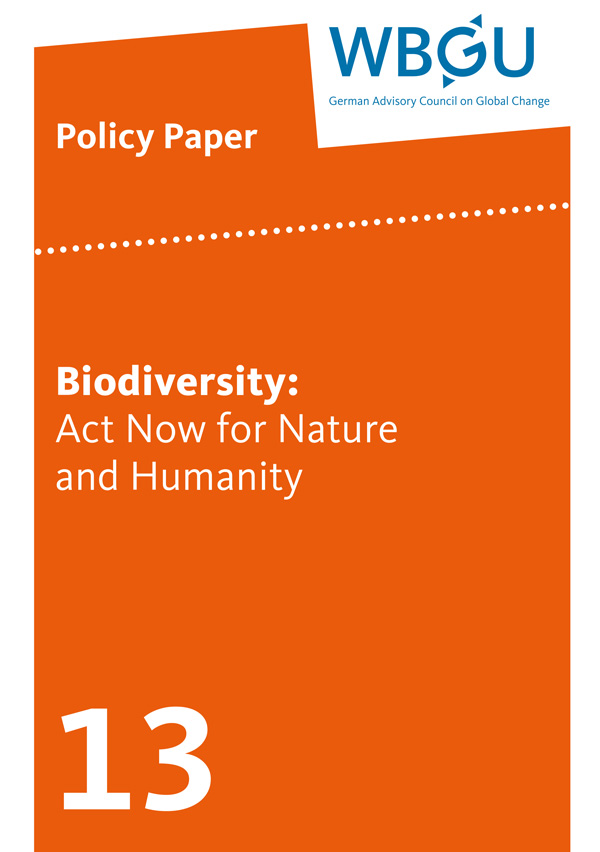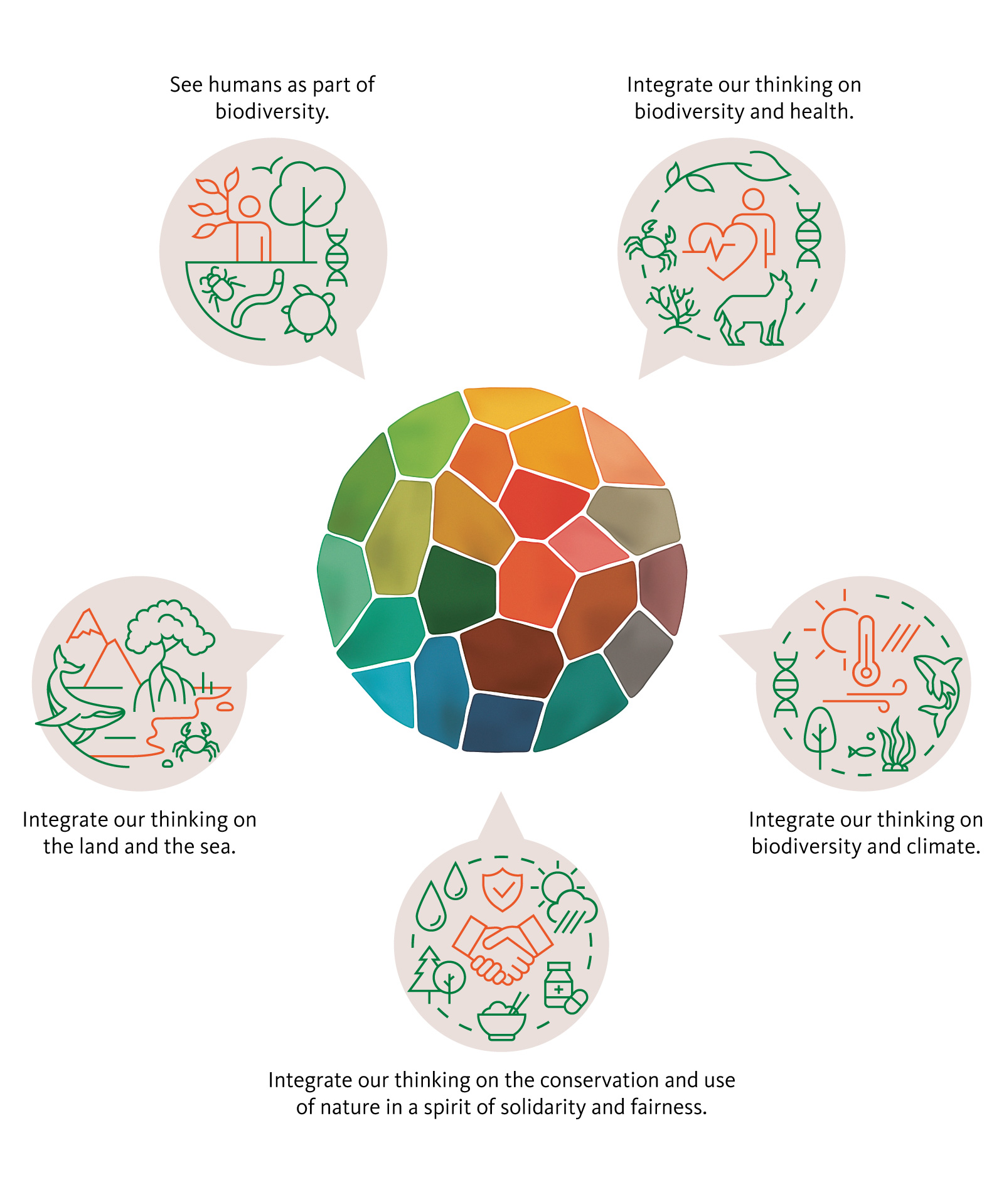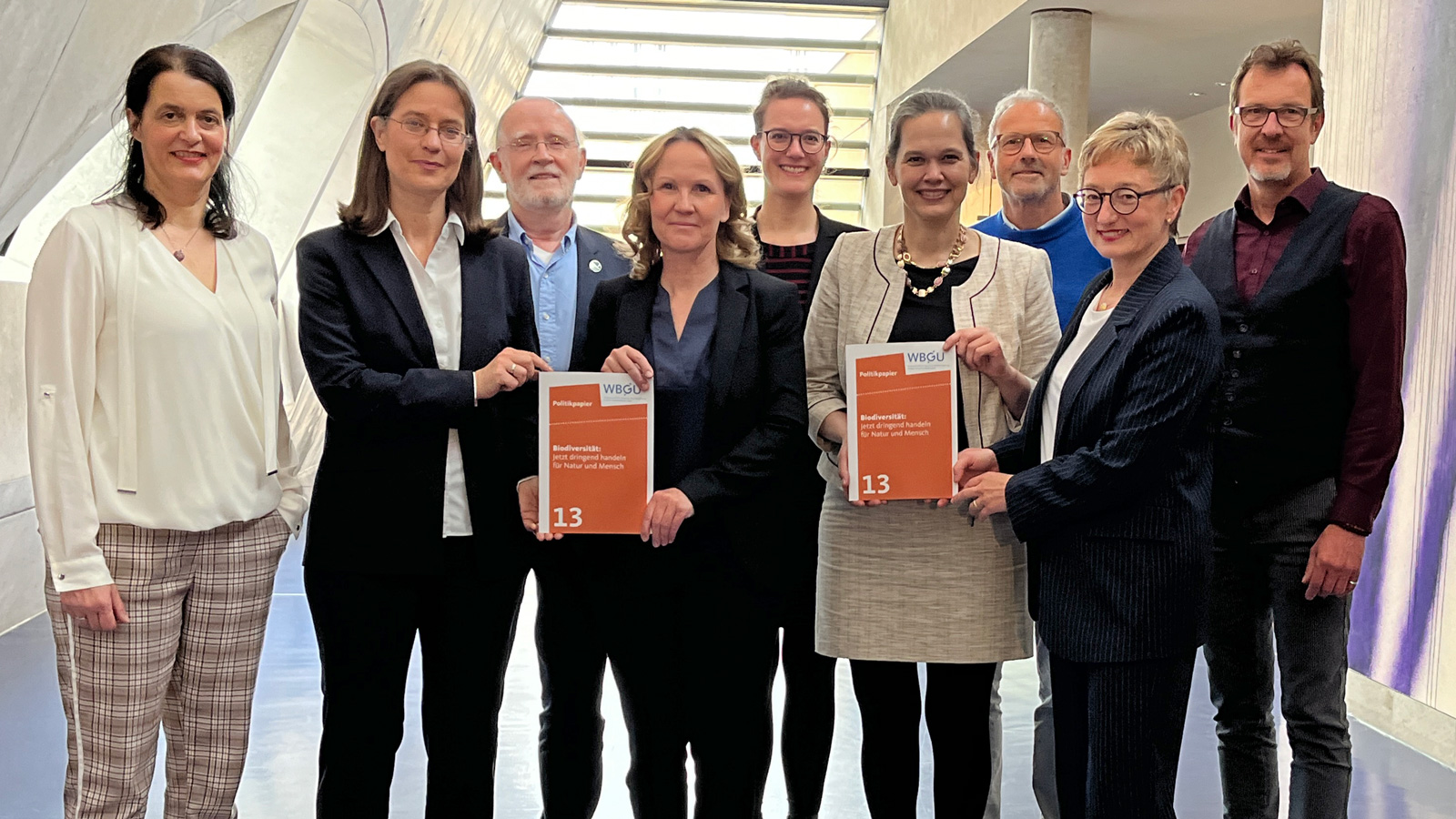
Biodiversity: Act Now for Nature and Humanity

Only if healthy ecosystems provide services essential for survival sustainably in a sustainable manner can also humans live healthy lives. This requires successful climate protection and biodiversity conservation.
Overview
In the case of biodiversity, the Kunming-Montreal Global Biodiversity Framework and the new UN Agreement on Biodiversity Beyond National Jurisdiction offer a unique window of opportunity. The WBGU recommends the guiding concept of a multifunctional mosaic of land and ocean uses: i.e. integrating our thinking on conservation and use in such a way that multiple benefits are created for nature and humanity. Germany should take decisive action internationally and launch processes to implement both agreements, set up dialogue forums and pioneering coalitions, and launch an education and communication offensive. Promoting biodiversity should not be financed with tax revenues alone, but also involve the private sector, for example by reallocating environmentally harmful subsidies and by ensuring clear reporting and taxonomy. The costs of inaction should be understood.
More about this topic
In 2022, the international community agreed on a new Global Biodiversity Framework (GBF) and in 2023 on the Agreement on Biodiversity Beyond National Jurisdiction (BBNJ). This political consensus reflects the scientifically proven urgency of biodiversity conservation and demonstrates the willingness to cooperate on this topic even in years of strained international relations. Biodiversity is a common good and an essential prerequisite for a healthy future for humans and all species with which they share the Earth. It enables ecosystem services, e.g. the provision of clean drinking water or the pollination of crops and wild plants; in order to secure such services, species and ecosystems need suitably large and interconnected areas. The WBGU proposes implementing the GBF's area-based targets according to the guiding concept of a multifunctional mosaic for land and ocean uses in which thinking on conservation and use is integrated in such a way that multiple benefits are generated for nature and humanity. This guiding concept offers all actors an orientation for behaviour that protects and promotes biodiversity.
Five principles for improved action on biodiversity
In order to achieve the global biodiversity transition set in motion by the GBF and BBNJ agreements, the WBGU has formulated five principles (Figure 1), stating that we need to: (1) see/humans as part of biodiversity, (2) integrate our thinking on biodiversity and health or human well-being, (3) integrate our thinking on the land and the sea, including the transition areas between the two, (4) integrate our thinking on biodiversity and climate, and (5) integrate our thinking on the conservation, restoration and sustainable use of biodiversity and ecosystem services in a spirit of solidarity, while sharing costs and benefits fairly.
Implementing the area-based targets
Important area-based biodiversity targets have been agreed internationally. The WBGU recommends the following for reifying and implementing them:
- Enable and promote a multifunctional mosaic approach: The implementation of a multifunctional mosaic of land and ocean uses should be enabled and promoted by means of integrated terrestrial and marine spatial planning.
- Protect at least 30% of terrestrial and marine areas worldwide with protected-area systems: In addition to protected areas that are strictly for biodiversity conservation, protected-area systems can also include zones that are networked with them, that promote biodiversity but permit graduated use at the same time. Protected-area systems should also have a positive effect on the planning and use of the remaining 70% of terrestrial and marine areas. The average use intensity of a mosaic of land and ocean uses should lead to a net gain in biodiversity.
- Define and take other effective area-based conservation measures (OECMs): OECMs should be defined internationally according to globally harmonized minimum standards; their implementation should be promoted. On the high seas, corresponding areas should be selected on a scientific basis by the Parties to the BBNJ Treaty.
- Incorporate all stakeholders in implementation: Civil-society, private and public stakeholders, e.g. landowners, associations and municipalities, as well as Indigenous and local communities should be involved in the selection and implementation of measures for conservation and use.
- Strengthen Indigenous and local communities: Recognizing and respecting their rights are explicit prerequisites for reifying the area-based targets under the GBF. They should be able to live autonomously in natural habitats, and their ways of life and autonomy should be respected and strengthened.
Germany's international role
In line with its position as a leading international political and economic power, Germany should visibly assume responsibility for action on biodiversity. The WBGU recommends:
- Moving forward resolutely, putting the content of the GBF and BBNJ in more concrete terms and coordinating implementation: Germany should stand firmly behind the GBF's area-based targets, work with other countries to swiftly submit proposals for area-based conservation measures and push for coherence and coordination between different environmental treaties.
- Initiating and designing dialogue forums and collaborations beyond thematic silos: All political levels must work together to protect biodiversity as a common good. Platforms for inter- and transdisciplinary exchange promote mutual understanding and the effective implementation of internationally agreed biodiversity targets. Furthermore, transformative cooperation projects should be initiated.
- Creating pioneering coalitions: Germany should initiate 'coalitions of the willing' and promote the concept of multilateral cooperation alliances. For example, standards for dealing with biodiversity could be jointly defined or conservation alliances set up to protect particularly valuable ecosystems from irreversible destruction and restore them.
- Preparing the first BBNJ Conference of the Parties: Together with other countries, Germany should launch an initiative to this end and work towards using the multifunctional mosaic of land and ocean uses as a guiding principle for the designation of protected areas and area-based conservation measures at sea.
- Launching an education and communication offensive for biodiversity: The aim is to raise awareness in society, the economy and politics of the importance of biodiversity as part of the life-support system for humanity and nature and to firmly establish the promotion of biodiversity as a cross-cutting political task. Research must be strengthened in order to achieve this.
Financing the promotion of biodiversity
Promoting biodiversity needs sufficient funding. Not exclusively taxpayers' money should be used for this purpose; rather, new sources of funding should also be tapped and the framework conditions for economic activities adapted in such a way that business and companies are made co-responsible for financing in accordance with the polluter-pays principle. The WBGU recommends:
1. Strengthening international biodiversity financing: Germany should work to ensure that the funding contributions in the context of the GBF are made as quickly as possible, not just gradually increased, and total well over US$200 billion per year.
2. Reallocating environmentally harmful subsidies in favour of biodiversity and quantifying the costs of inaction: Reducing subsidies could free up considerable financial resources for biodiversity-friendly measures. Criteria of climate-change mitigation and biodiversity conservation should be taken into account when designing existing and new subsidies; the costs and benefits of both inaction and action should be quantified and options for action comprehensively researched.
3. Promoting international cooperation by both market-based and non-market-based instruments: Corresponding mechanisms could support countries in achieving more ambitious biodiversity targets than would be possible on their own territory. The extent to which market-based approaches such as international trading in biodiversity credits might be possible and expedient should be carefully examined in view of the foreseeable complexity, as well as possible land-use conflicts and human-rights violations.
4. Making the private sector take responsibility for financing through clear reporting and taxonomy: Germany should work to ensure that the EU's approaches to including biodiversity in reporting and taxonomy are internationally adopted, standardized and made mandatory worldwide.
5. Prioritizing biodiversity in international financial instruments: In both bilateral and multilateral cooperation, measures for the sustainable use, restoration and conservation of biodiversity should be promoted and prioritized in loans and guarantees, e.g. through the use of debt-for-biodiversity swaps.



